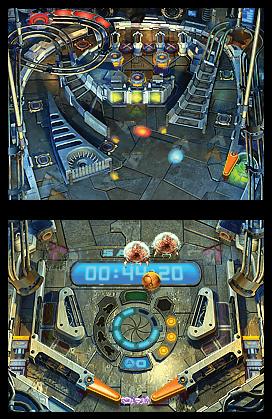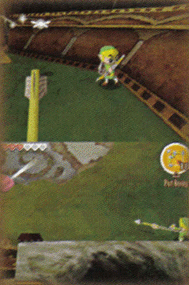What's the opposite of a map screen? It must be a gameplay screen. Ever since the days of the Game & Watch handheld gaming machines, we have gamed on one screen at a time. Ignore that next-gen demo that used 3 HD TVs side by side to create a panoramic view. Ignore those games at the arcade with the composed of several smaller screens fitted together. The DS has brought dual screen gaming to the world. Designing a game utilizing both DS screens for simultaneous gameplay is tricky. Some have done it well. Others have crashed and burned. Fortunately, we can learn something from all of these dual screen gameplay games.
To design a good dual screen gameplay game for the Nintendo DS, one must understand the limitations of human sight and how our eyes work. Without getting too technical, the DS screen is small forcing players to focus their eyes on a single spot at a time. This makes it impossible to focus on both DS screens at once. Even if a player is very good at shifting their focus back and forth between the two screens, their attention is ultimately divided and their capacity reduced. The type and amount of vital information that is displayed on both DS screens and the time players are given to make informed decisions is key to creating a successfuly dual screen gameplay experience.
I've organized the different categories of dual screen gameplay design into these styles...
Two Separate & Simultaneous States
This style of dual screen gameplay design gives both screens challenges that are largely parallel. For example, if one screen has a character, enemies, and particular level elements, the other screen will display a matching set of elements. Just think of it like playing two games at once.
The World Ends With You (TWENY)
The battle mode in this RPG is the wrong way to design dual screen gameplay. Basically, each screen displays a battle area with enemies and a player character. The bottom screen is all touched based while the top screen is controlled completely with buttons. Though the top screen battle system isn't as intense as the bottom screen's, unless you're this guy, playing TWENY is too difficult because it's literally like playing two games at once. It would be different if the two battle states were linked in such a way that the player could understand what's happening on both screens by focusing on one. It would be different if there were clear sound cues that alerted players to which screen's character is in immediate danger. And it would be different if the gameplay on either screen wasn't so cluttered visually and mechanically. Many have spoken out on the steep learning curve and/or the design of TWENY's battle system including me. It's not the players fault. We're only human.

Advance Wars: Dual Strike (AW:DS)
Some missions in AW:DS are special dual front missions. Unlike TWENY, AW:DS is a turned based game. So when large scale battles are layed out on two fronts, by the air and along the ground, the pressure of active time is never an issue for the player. In such missions, players have the ability to send high altitude flying units up to the top screen to fight on the aerial front. The drawback to this maneuver is that all units on the top screen can never return back to the bottom. Winning the ground based bottom screen battle is the ultimately goal. Whichever side wins the the top screen air battle gets a significant bonus in the ground battle. To make things more interesting, in one particular mission (see above), a sky fortress on the top screen drops bombs down onto the bottom screen battle. In these ways, each screen features a largely separate battle that is connected to the other screen's battle in unique ways. AW:DS is dual screen gameplay done correctly.
An Expanded Game View
These games display the game view across both screens at once creating a sort of wide screen view of the game world (minus the dead zone in the middle of the DS screens). This category only includes games that are set up like traditional single screen games on one screen and display the expanded view on the other. In other words, for the most part these games play like single screen games taking advantage of the expanded game view to hide secrets and alternate paths.
Sonic Rush & Sonic Rush Adventure
One of the biggest design dilemmas that has plagued the 2D Sonic games is the limited screen view. Before, when zooming around as Sonic, the faster the player moved, the harder it became to see where you were going, react to enemies, avoid pits, etc. To fix this problem, the Sonic Rush series' game view is displayed on both screens at once. If there's a jump coming up, you'll see it coming on the bottom screen. If there's an alternative path above you, you'll see the coming on the top screen. Also, the death pits are largely confined to the bottom screen sections. Because of this design, players learn to be careful on the bottom and let loose on the top screen. Because gravity constantly pulls all things downward, all the best (safest & shortest) alternate paths are positioned at the top of the level. The penalty for missing jumps is simply falling to lower and lower paths until finally dropping the player into a pit. Such a simple design organization fixed a lot of the problems Sonic games have suffered from in the past if only for the y axis. The RUSH mechanic fixes that pesky problem of running into enemies you can't see in time along the x axis. For these reasons, the Sonic Rush games have become my favorite Sonic games.
Yoshi's Island DS
Yoshi wasn't designed with as much care as Sonic. Because the gameplay in Sonic is fast, fluid, and almost roller coaster like, players are able to go with the flow while navigating safely and successfully. Also, in Sonic, playing on either the top or bottom screen is fixed into the level design (see video above). Low areas are displayed on the bottom screen, and as the player climbs Sonic is transferred to the top screen. In Yoshi's Island DS, players are free to play on the top screen, bottom screen, and even in the dead zone between DS screen. In the video above, the game doesn't seem to be in focus. The view on the expanded screen shows too many blank walls and open spaces. The expanded game view also tends to obscure vital information. Enemies, platforms, and pick ups can be hidden out of view even when you're standing right new to it. Being able to adjust the view helps somewhat, but it's not enough to remedy the frustration that comes from being hit by an enemy hiding in the dead zone.
Yoshi's Touch & Go
Because the levels in this game are design on a very linear, unidirectional track, and the player doesn't have control of the camera, the obfuscation problem is greatly reduced. Compare the video for Yoshi's Touch & Go to Yoshi's Island DS and you'll notice a clear difference.
Dual Screen Game View
Unlike the expanded game view style, dual screen game view games are designed around the separation between the two DS screens including the dead zone gap in between them. These games usually focus on aiming, making the player lead shots and draw trajectories across both screens.

Super Mario 64 DS/New Super Mario Brothers minigames
- Snowball Slalom
- Lakitu Launch
- Danger, Bob-omb! Danger!
- Baloon Racing
- Bob-omb Squad
- Trampoline Time
- Bounce and Trounce
Club House Games
- Darts
- Bowling
Space Invaders Extreme
- Bonus stages
- Boss stages
Tetris DS
- Fast Match
- C Match
Alternative Game View


The Legend of Zelda: Phantom Hourglass is the only game I know that uses a 2nd person camera. If first person is from the eyes of the player character and third person is from a pulled back point of view (often over the shoulder or birds eye view), then 2nd person must be from the perspective of the enemy. Crayk is a boss that camouflages itself to hide from Link. Fortunately, the top screen shows the game world from its point of view (image left). Because the normal game view on the bottom screen and the new 2nd person view on the top screen both display the same area, players are able to determine the boss's location and fire an arrow right into its eye/perspective on the top screen. In addition to Crayk, the final boss Bellum (image right) also uses the top DS screen to give the player an additional view point of the battle.
Enemy View
In some multiplayer DS games, being able to see what the opponent is doing is important. This type of game design generally doesn't exist in PC games or any games outside of Nintendo systems. When playing an FPS on consoles using split screen, many gamers are adamently against screen watching; deliberately looking at your opponent's screen to gain valuable information. Instead of pretending to ignore the opponent's actions, Nintendo games embrace being able to see all. Pikmin 2's multiplayer works well on a split TV screen, and these DS games do too.

- Meteos
- Sonic Rush
- Tetris
- Planet Puzzle League
- Elite Beat Agents
- Space Invaders
In conclusion, displaying gameplay on both DS screens can making things twice as complicated, confusing, and frustrating, or it can make the player twice as secure, knowledgeable, and empowered. Ultimately, bouncing back and forth between the two screens is key. The two screen should be designed to enhance the experience of one game, not force the player to needlessly juggle two.